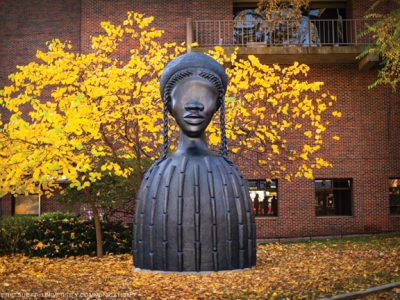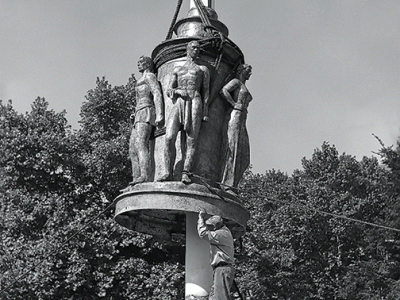When sculptor Frederic Blatt’s daughter was in high school, she had to turn in a report on Walt Whitman. “She didn’t know what he looked like,” Blatt says. “That seemed strange. These kids hear about famous people, but don’t know their faces. When I grew up we had their pictures on the classroom walls. They’re part of our mythology.”
Blatt, FA’71, reread Whitman’s poetry, then cast a bronze of the poet’s head as his daughter’s graduation present. Someone who saw it commissioned a head of Robert Frost. Next came requests for H.L. Mencken and Ernest Hemingway.
To date, his portrait busts could fill a small Norton anthology: more than 20 portrait busts executed in hydrostone, (“100 percent dead writers,” Blatt jokes) from Cooper and Poe to Woolf and James. Each one holds significance for him, and for inspiration he goes straight to the source. “I read the texts. I study the existing photographs. I try to choose one primary look.
“Poets are simpler, in a way,” Blatt says. “I read Leaves of Grass before doing Whitman. To me he has the sound of wind coming through a mask, so I gave him an open mouth. With novelists, I work from biography, their histories, and also their paintings and photos. For Eugene O’Neill,” he explains, “knowing his alcoholism, I made the face a little haggard. For F. Scott Fitzgerald, I chose him when he was young, when he was putting on an image, a mask to confront the world. “Everyone has a whole mythology with him, not [just] a particular smile or expression,” Blatt says. He strikes only 100 images a year of each subject.
Before coming to Penn, where he majored in studio arts, Blatt says, “There was nobody with less art in his life. I was a jock.” But a course he took in cultural anthropology led to an intensive analysis of tribal sculptures and masks: “How and why does an artist act? How do you turn raw wood or clay into a living thing? Fortunately, I knew nothing, I’d drawn nothing; so I had nothing to unlearn,” Blatt says. “I wound up doing independent study in sculpture.” And there he found his gift.
After graduation he continued his studies, learning welding, stone-carving, and other essentials. He taught part- time, carving in his free hours. In 1988 he escaped from city life to the Catskill hamlet of Fly Creek, N.Y., where today he works in a converted barn. A propane heater struggles to keep him warm in winter; a ceramic kiln cooks his wares; sculptures, reliefs and photos stand along wooden shelves. Blatt’s prolific output, which has always included painting, has expanded to small porcelain discs of philosophers and artists, among other projects. He sets up professional shows and he keeps teaching. “I’ve taught every age,” he says. “I’ve taught the disabled, I’ve taught a blind man to sculpt.”
Local galleries exhibit his work, and he sells by mail-order and telephone from his home. His best seller? A seven-inch-high head of Emily Dickinson — until this year. “Now it’s Jack Kerouac,” he says. “What a change!”
— Robert Gordon




